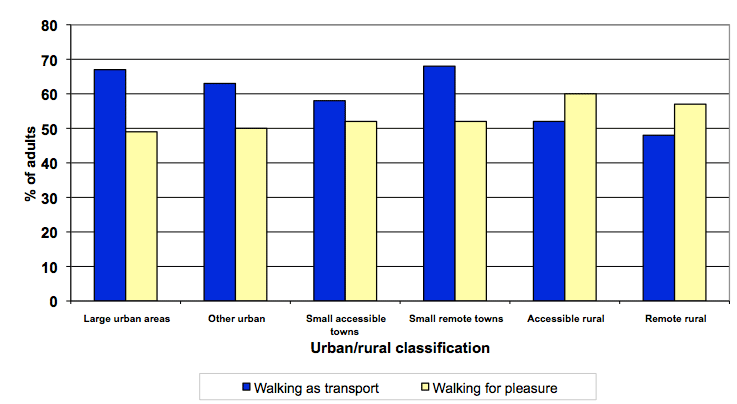Transport and Travel in Scotland 2010
Summarises a broad range of transport statistics including road vehicles, traffic, casualties, bus and rail passengers, road and rail freight, air and water transport and personal travel as well as providing some comparisons with GB figures. Further breakdowns of Scottish Household Survey transport data including households' access to cars and bikes, frequency of driving, modes of travel to work and school, use and opinions of public transport and access to services are also presented.
5 Walking and Cycling
- Fifty-one per cent of respondents had walked at least a quarter of a mile for pleasure in past seven days in 2010.
- Sixty-two per cent of respondents had walked at least a quarter of a mile as a means of transport in the past seven days.
- Thirty-four per cent of households had access to at least one bicycle for adult use in 2010 (a similar figure to 2000).
- Respondents living in urban areas and towns were more likely to walk as a means of transport and less likely to walk for pleasure than respondents living in rural areas.
Frequency of walking
5.1 In 2010, 62 per cent reported of respondents to the Scottish Household Survey reported walking as a means of transport on at least one of the previous seven days, an increase from 54 per cent in 2000. There has also been a more steady increase in those who walked for leisure - from 41 per cent in 2000 to 51 per cent in 2010. [ Table S3]
5.2 Around 18 per cent of respondents had walked as a means of transport and a similar proportion said they had walked for leisure in the last 2 days. [ Table 3]
5.3 Note: These figures only include journeys longer than ¼ of a mile. The figures are higher than the travel to work question (See Section 6) and will include journeys where walking is a stage of the journey but not the longest distance ( i.e. 'main') mode. [ Table 3]
Age/gender
5.4 Gender had no effect on frequency of walking, either as a form of transport or for pleasure. Older people were less likely to walk, particularly those over 80. Only 24 per cent of those aged 80 and above had gone for a walk for pleasure in the last seven days, compared to the average of 51 per cent for all adults. [ Table 24]
Income
5.5 Income had little effect on transport related walking journeys but households on high-incomes were more likely to make pleasure related walking journeys in 2010.
Urban/rural
5.6 Those living in urban areas and towns were more likely to walk as a means of transport compared to those living in rural areas. However, they were less likely to walk for pleasure, with only 48 per cent of those living in large urban areas responding that they had walked for pleasure in the last seven days compared to 57 per cent of respondents living in remote rural areas. (Figure 17)
Frequency of driving
5.7 Unsurprisingly, the frequency of driving affected the percentage of transport walking trips recorded in the past seven days but it had little significant affect on the percentage of pleasure walking trips.
Figure 17: Walking as a means of transport or for pleasure by urban/rural, 2010
(on one or more of the previous seven days)

Bicycle access
5.8 Thirty-four per cent of households had access to at least one bicycle in 2010, a similar figure to 2000. [ Table S3] The percentage of households with access to a bicycle varied with household type with families and large adult households the most likely to have access to a bicycle (49 - 63%) and single pensioners the least likely to have access to a bicycle (6%). [ Table 17]
5.9 As household income increased so did the likelihood of the household having access to at least one bicycle, with 66 per cent of those in the highest income bracket (over £40,000 per year) compared to 16 per cent in the lowest income bracket (up to £10,000 per year).
5.10 Similar patterns can be seen in the deprivation and the urban/rural figures. As levels of deprivation decrease, the likelihood of a household having access to a bicycle increases and as rurality increases, the likelihood of having a bicycle also increased.
There is a problem
Thanks for your feedback